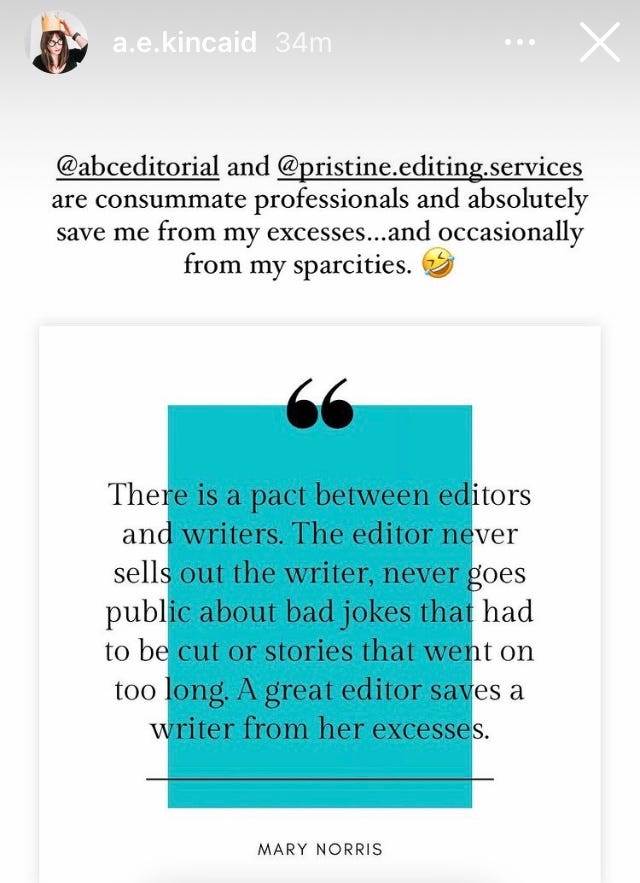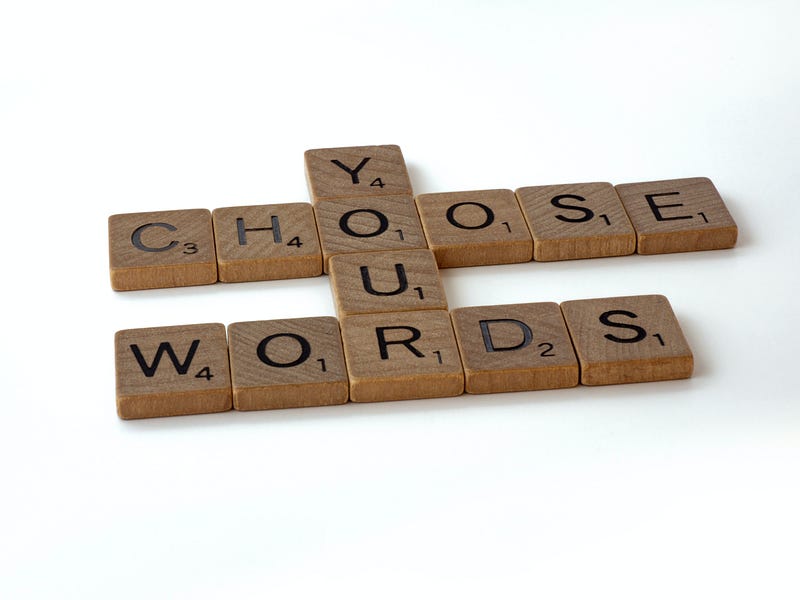Why Is Copyediting Important?
Copyediting is quality assurance.

Photo by
on
Think you can get away with not copyediting your content? Think again.
Your audience values error-free content. The quality of your written content affects their purchases and their perception of your brand.
No matter what type of content you are releasing to the world, you need a copy editor. Nothing says unprofessional and untrustworthy like poor language.
Plenty of research confirms the value of copyediting.
Copyediting is an important function for the integrity of both print and digital content, a 2007 study reported.
Readers can tell when a news article isn’t edited, and it affects their perceptions about the news and their willingness to pay for it, according to a 2015 study. Even college-aged people value edited content free of errors: “Digitally savvy young people picked up on editing differences and reacted negatively to unedited content,” says an American Press Institute blog post about the study.
People have similar standards for marketing copy. A SurveyMonkey survey found that 85% of millennials are less likely to buy a product advertised with errors, and the same is true for 83% of people with a household income of $75,000 and higher.
Poor spelling and grammar are warning signs of an email scam.
And, of course, editing contributes to the success of books: 74% of book authors who earned more than $5,000 in sales invested in editing, while 53% of authors who earned less than $100 in sales did not invest in editing, according to a 2017 BookBaby survey of nearly 8,000 indie authors.
But I get it. You have a lot on your plate. Editing your content falls by the wayside in the rush to share it with the world.
That’s where Pristine Editing comes in!
We offer professional editing services that integrate seamlessly into your existing workflow. Send us your copy, turn your attention to other tasks, and in no time at all, we’ll return your pristine content to you.
Your audience will get the full impact of your words without being distracted by weird phrasing or misplaced punctuation.
Whether you’re a publication with tight deadlines, a freelancer or a small business launching a website and a newsletter, or a large company or organization about to release a white paper or cross-platform marketing campaign, Pristine Editing can contribute to the unwavering high reputation of your brand.
Kick-start a conversation with Pristine Editing by filling out this two-minute project request form.
Enjoy this post? Buy me a coffee in support.
Hi, I’m Jaime, editor and owner of Pristine Editing LLC. To get to know me better, and for more editing tips, sign up for my quarterly email newsletter! You can also follow me on LinkedIn and Instagram. And don’t miss out on my free style guide template.
6 Tabs I Always Have Open as I Copyedit
These references are my constant companions
Ever wonder what goes on behind the scenes when a copy editor polishes your content? It’s mostly reading a sentence three times and sometimes going back to read it a fourth; pondering; and looking things up.
As editor Crystal Shelley of Rabbit with a Red Pen once said, “Editing is just looking things up until you die.”

Photo by
on
What are editors looking up?
correct style (e.g., does the client want it to appear as 10 or as ten, as colour or color; do they use accent marks or no; do they like the ellipsis character mark or the three periods plus three spaces)
correct spelling
dates and job titles, etc. (to confirm them, in a sort of light fact check)
obscure grammar rules we don’t know off the top of our head or want to double-check for a tricky situation
definitions of words to make sure the writer has used them well
The list goes on.
To look up that stuff as I copyedit, I always have these six tabs open:
The Chicago Manual of Style or The Associated Press Style Book
clients’ house editorial style guide
site:website.com and “X”
The Chicago Manual of Style hyphenation guide
online search engine
‘The Chicago Manual of Style’ or ‘The Associated Press Style Book’
The two most typical style guides my clients use. Depending on the project, I’ll have one of them open for reference (I subscribe to the online versions). These resources offer guidance on everything from grammar, punctuation, and formatting to the correct usage of numbers, abbreviations, capitalization, and more.
Clients’ house editorial style guide
Many clients—though not all—use a house style guide in addition to one of the industry-wide guides above. I love when a client has an editorial style guide, but for clients who don’t, I can easily create one. These house guides contain specific preferences and brand-related language use that enables me to tailor the copyediting process to each client.
site:website.com and “X”
This online search engine technique comes in super handy mainly when a client doesn’t have a house style guide, and even when they do.
Typing site:website.com into a search enginerestricts the search results to only pages from the specified website. To search for a specific word or phrase, I add it in quotation marks after site:website.com and the word and: e.g., site:website.com and “X” searches for the exact word or phrase “X” on that site.
I use this tool to quickly find out how a client has typically styled a word or phrase on their website. It’s a great way to determine how a publication or organization has most commonly styled a word—even if the staff themselves aren’t sure. For example, imagine my client is The Daily News Bites, and the newspaper has a house style guide, but it doesn’t specify to use healthcare or health care as a noun. I can search site:dailynewsbites.com and “health care” as well as site:dailynewsbites.com and “healthcare” to see which style the newspaper uses most often (and then I can add that preference to the style guide I make for the client).
To use this tool successfully, I need a search engine that lists the number of search results so I can determine which style is most common.
That’s the entire reason I stopped using Google Search and now use Microsoft Bing. I’d love to use a data-privacy search engine like DuckDuckGo (I did use Neeva before it went belly up), but again, seeing the number of search results is critical, and DuckDuckGo doesn’t allow that.
https://x.com/PristineEditing/status/1483573898973220870
Merriam-Webster
My go-to dictionary. In May 2024, AP style made M-W its official primary dictionary, which means I can use M-W for all of my clients, whether they use Chicago or AP style.
I most often use Merriam-Webster to:
check hyphenations
see if a foreign word is listed (if a foreign word appears in M-W, it doesn’t need to be italicized, as is common style for foreign words — although there are exceptions to that)
clarify the precise meaning of a word in context to make sure the writer’s word choice is accurate
The ‘Chicago Manual of Style’ hyphenation guide
Half the time I’m searching for a word in Merriam-Webster, it’s simply to check if a word is hyphenated or not. This guide provides clear rules for hyphenation (for Chicago style, that is), ensuring uniformity of style throughout a document.
Online search engine
I’m constantly searching for nouns and proper nouns—company names, historical figures, scientific terms, etc.—to check that they’re spelled correctly and in the correct case (e.g., capitalized or lowercase).
This often leads to a little fact-checking too. In looking up the spelling of a politician’s name, for example, I’ve occasionally caught a writer calling that politician a senator when they’re a House representative.
Similar to site:website.com and “X” above, I often use an online search engine to determine which style for a word or phrase is the most used (and therefore the most SEO-friendly). For example, if I want to determine whether school teacher or schoolteacher is more common, I add quotation marks around each term in the search: e.g., “school teacher” and “schoolteacher.” Microsoft Bing tells me that school teacher has 36,200,000 results while schoolteacher has 138,000 results.
So, there you have it! These six tabs are my trusty crew when it comes to copyediting. Having these resources readily available allows me to ensure my clients’ content adheres to the highest editorial standards.
Do you have any questions about these resources or the copyediting process in general? Feel free to leave a comment below.
Enjoy this post? Buy me a coffee in support.
Hi, I’m Jaime, editor and owner of Pristine Editing LLC. To get to know me better, and for more editing tips, sign up for my quarterly email newsletter! You can also follow me on LinkedIn and Instagram. And don’t miss out on my free style guide template.
9 Overloved Words and Phrases
Cut these from your content on Valentine’s Day (and always)
Those extraneous embellishments in the form of unnecessary adverbs, redundant adjectives, and vague nouns are smothering your words of note.
Show them a little love by giving them room to breathe.
Here are 9 overloved words and phrases to delete from your content now.

Photo by
on
1. the fact that
William Strunk Jr. and E.B. White, authors of the ubiquitous The Elements of Style, say the fact that is an “especially debilitating” expression that should be cut without exception.
The fact that can almost always be replaced. Here are some common replacements, according to The Elements of Style:
owing to the fact that —> since/because
in spite of the fact that —> though/although
call your attention to the fact that —> remind/notify you
I was unaware of the fact that —> I was unaware that/I did not know that
the fact that he had not succeeded —> his failure
the fact that I had arrived —> my arrival
Often, cutting the fact works well too:
“Putting aside the fact that nearly 1 in 4 Americans are unable to afford medical treatment” can become “Putting aside that…”
2. actually
Benjamin Dreyer, former copy chief of Random House, wrote in his book, Dreyer’s English, that actually can almost always be cut. We use it colloquially for emphasis, but it’s just drowning what would otherwise be a firm statement.
Dreyer goes on to suggest we also cut very, rather, really, quite, in fact, that said, pretty (the adverb, as in pretty great), of course, and that said.
3. first-ever
“It was the first parade in the town” means the same as “It was the first-ever parade in the town,” without the extra word.
If something is the first, we know it is the first…ever.
4. just/only
These, in adverb form, are often used before a measurement or number of some kind to emphasize the amazement of that measurement/number. “The round-trip flight costs just $300!” “The runner completed the marathon in only 3 hours!” But if the measurement/number is so amazing, it doesn’t need your petty just or only.
5. there are
There are delays the reader’s arrival to the substance of the sentence. (I was so close to writing just delays and then edited myself!)
“There are dozens of restaurants in the neighborhood that serve excellent pizza” can easily be “Dozens of restaurants in the neighborhood serve excellent pizza”—and it saves the audience from three say-nothing words (e.g., there are and that).
6. In addition to + also
Also is redundant when it follows an introductory participle phrase using in addition to.
For example, we don’t need to say, “In addition to providing delicious food, the restaurant also offers gorgeous views.” Cut the also.
Another example: “In addition to introducing new routes and destinations, Breeze also is expanding its fleet.” Cut the also!
7. that
Editors argue over this one. Some are totally against the overuse of that as a conjunction. Others say it’s necessary for clarity.
Personally, I’m all for excluding that wherever possible. It’s okay to write, “She told me you were going to the party,” instead of “She told me that you were going to the party.”
8. Unnecessary verb + preposition pairs
This one is my pet peeve. Do you really need to say open up? Or does open suffice?
You don’t need to say “She climbed up the ladder.” “She climbed the ladder” is sufficient.
Write out is another. You don’t need to say “She wrote out her name on the chalkboard.” “She wrote her name on the chalkboard” is great.
Conjure up should just be conjure.
Printed out —> printed. Seek out —> seek. Rise up —> rise.
The water cools down to 70 degrees —> The water cools to 70 degrees.
Next time you encounter a verb + preposition pair, ask yourself if the preposition is necessary.
9. including + and more
Including and and more are often used in a list of items, or a series, but as a general rule, they shouldn’t appear together.
Don’t say, “The city has tons of attractions, including a circus, museums, an array of restaurants, and more.”
Including already implies that a circus, museums, and an array of restaurants are only some of what the city has to offer—so we don’t need to say and more, which is vague anyway.
Alternatively, you might write, “The city offers a circus, museums, an array of restaurants, and more.”
https://x.com/PristineEditing/status/1757873535907688663?s=20
Enjoy this post? Buy me a coffee in support.
Hi, I’m Jaime, editor and owner of Pristine Editing LLC. To get to know me better, and for more editing tips, sign up for my quarterly email newsletter! You can also follow me on LinkedIn and Instagram. And don’t miss out on my free style guide template.
Case Study: The Atlantic/Google
How I helped The Atlantic’s creative content studio by copyediting a magazine for Google in a week

Dialogues, a Google magazine produced by ABP
Situation
In October 2023, Atlantic Brand Partners, the creative content studio of The Atlantic,asked me to copyedit a major project with one week from that day: a print magazine on artificial intelligence that ABP was producing for Google. The print magazine would include 16 stories (some interviews, some essays) in total, ranging from about 1,000 to 3,000 words.
Task
But there was an added challenge.
I only had 24 hours to copyedit each story. ABP would send the stories in Google Docs to me piecemeal, and I would edit them immediately: If I received a story by 10 a.m., ABP needed it back by 10 a.m. the next day. If I received a story by midnight, I had to return it by midnight the next day. Designers and other teams were working round the clock on this project.
Action
My agenda for October was already full, but the project sounded too cool to turn down. (I love copyediting print magazines.) So I rearranged my schedule as much as I could by asking my other clients who I knew might have flexible timelines if they would accept a deadline extension. I worked late and woke up early in order to meet ABP’s grueling schedule.
I also created a project management document in Google Sheets that would allow the ABP team and me to track each piece, word count, and deadline and rely on automatic notifications to reduce emails.
During the copyedit, I adhered to The Atlantic style, made corrections for grammar, punctuation, spelling, and syntax, and left comments with larger questions and concerns, as well as suggestions for fixes wherever possible. I caught mathematical/statistical errors. I communicated with editors to resolve larger concerns in a way that worked for all parties involved.
Result
In one week, I copyedited 44,070 words, allowing ABP to create a gorgeous magazine on a super crunched deadline for a major client.
Here is the resulting testimonial from Elizabeth Haq, who oversees editorial content and brand partnerships for ABP: “Thank you sincerely for the wonderful work you put into it. I think it turned out amazing, and the client agrees.”
Another editor who worked on the project, Gabriel Muller, said, “Thanks for all your great work on the Google Magazine. I’m always so impressed by the details you’re able to catch.”
Want to see the finished product for yourself? Check out the magazine and download it here.
Enjoy this post? Buy me a coffee in support.
Hi, I’m Jaime, editor and owner of Pristine Editing LLC. To get to know me better, and for more editing tips, sign up for my quarterly email newsletter! You can also follow me on LinkedIn and Instagram. And don’t miss out on my free style guide template.
Case Study: Tablet Magazine
How I helped Tablet Magazine by copyediting a longform article in two days

Photo by
on
Situation
In November 2022, Tablet Magazine, whose daily newsletter I edit, asked me to copyedit an unprecedented project: a 24,000-word story that would be published just after the Jewish holidays.
(FYI, that’s the size of a novella. The daily newsletter is 1,300–2,500 words.)
“It’s an incredibly moving and profound piece, and a pleasure to read,” the editor told me. The copy would be ready for me in mid-December, and I would have a week and a half to edit it.
Tablet has talented writers on staff and publishes nuanced, thought-provoking content, so I eagerly added the project to my schedule.
Task
On December 5, the same editor emailed me again: “Can you edit it in two days if I send it to you tomorrow?” Ah, news organizations with their fluid timelines.
It was Tablet’s biggest magazine event of the year. All hands were on deck, and the design team had put in a lot of work to make the digital story look amazing.
The editors at Tablet had been immersed in this story for months and needed fresh eyes.
Action
Because it was the end of the year, when everyone tries squeezing in projects before the holidays, my agenda was packed.
But I rearranged my entire schedule. I burned the midnight oil. And I delivered the copyedit of what was indeed an incredible story to the editor by the required deadline.
I gave this incredible piece justice by removing errors in grammar, punctuation, spelling, syntax, and style, and I flagged discrepancies in dates, names, and other details in a story that features a web of many storylines.
You can read the story, “The Rower” by David Samuels.
Result
Here is the resulting testimonial from the editor, Jeremy Stern:
“Jaime ensured that our biggest magazine event of the year — a near book-length essay that was reported over multiple years and continents, and included dozens of well-known and unknown characters and historical events — was as professionally copyedited as a major publisher’s printed book, fulfilling every exacting editor and reader’s expectation of error-free, stylistically uniform prose. She also did so on a brutally short deadline, which made the result even more impressive. I would enthusiastically work with her again on similar projects in the future.”
Why I Loved This Project
The story was incredible. So much time and effort has gone into creating it, and I was able to use my copyediting skills to polish the piece for publication, removing lingering issues that would distract readers and discourage them from reading 24,000 words.
I was able to accomplish that within Tablet’s time restrictions. If you’re considering using a freelance copy editor but are concerned that working with one would delay your content’s publication, know that it’s very feasible to integrate the copyediting step into your process.
As a freelance editor, I have control over my own schedule, with the ability to reorganize my agenda to suite client needs and accommodate their timelines.
Enjoy this post? Buy me a coffee in support.
Hi, I’m Jaime, editor and owner of Pristine Editing LLC. To get to know me better, and for more editing tips, sign up for my quarterly email newsletter! You can also follow me on LinkedIn and Instagram. And don’t miss out on my free style guide template.
A Roundup of My Favorite Quotes from ACES Accelerate
Nuggets of wisdom from writers and editors to other editors
ACES Accelerate was a virtual conference held by ACES: The Society for Editing, of which I am a member. There was so much to take away from the sessions at this conference that I could write many a blog post in reaction (coming soon!), but I wanted to share a quick roundup of my favorite quotes from a few presenters.

Photo by
on
Jenny Lawson, aka The Bloggess, is a blogger turned NYTimes-bestselling author who was the keynote speaker at ACES Accelerate. She had us laughing throughout her whole speech yet at the same time shared poignant insights on the writer-editor relationship, which is the exact charm of Jenny Lawson.
Cara Reedy, director at Disabled Journalists Association, and Wendy Lu, a senior staff editor at The New York Times, presented on avoiding disability euphemisms in the news. A couple points Reedy made stuck with me.
Lisa McLendon, who runs the Bremner Editing Center at the University of Kansas journalism school, offered some gems of advice that apply to all copy editors. Both of these are golden rules of copyediting.
Enjoy this post? Buy me a coffee in support.
Hi, I’m Jaime, editor and owner of Pristine Editing LLC. To get to know me better, and for more editing tips, sign up for my quarterly email newsletter! You can also follow me on LinkedIn and Instagram. And don’t miss out on my free style guide template.
How I Doubled My Business from 2020 to 2021
My aggressive growth plan paid off. Here’s everything I put in motion.

Photo by
on
In August 2020, after more than two years working as a full-time freelancer, I realized that my business had become stagnant. Since I had begun independently providing writing and editing services to clients in early 2018, my business had not changed. My client base largely remained the same, as did the way I operated day to day. Although the work was steady, I knew it was in a precarious position: The loss of one major client would disrupt my business and significantly decrease my income. I had to be better prepared in case that occurred.
What’s more, I knew my business practices needed a refresh. I was curious how investing in my skills and knowledge relating to technology, marketing, and other areas would affect my business. I wanted to see how viable working for myself could be in the long run. So, in mid-2020, I made a plan to aggressively grow my business.
The Early Years of My Business
From January 2018 to August 2020, I relied completely on client referrals. I didn’t have a website, and I didn’t use social media. All of my clients could be traced to the network of contacts I made as a magazine copy editor in NYC. (Most notably, I led the copyediting department at Time Out North America as national copy chief.)
In those two years, I focused on client satisfaction and retention, building a modest yet stable freelance business. I fine-tuned my skills as a copy editor and a line editor for a diverse client base that needed me to edit a wide range of media: short- and long-form online articles, print and digital magazines, video, social media, website copy, books, brochures, apps. I became expert in adjusting my style of editing to each client’s style and voice and each content form.
However, in 2020, my business reached a plateau. It was reliable, but it was not growing. As is common for freelancers, I would often find myself in feast-or-famine situations: Some weeks I would be swamped with work, and other weeks projects would trickle in. I wanted to standardize my workload every week. Plus, the work no longer challenged me. So I developed a plan for a new way forward.
The Aggressive Growth Plan
In September 2020, I took a six-week online freelance-writing course on how to grow a business to $5,000 a month (the subject matter applied to most freelancers of all kinds). That course covered mindset; how to build and manage a website and social media; how to identify your ideal target client; client relations and contracts; negotiating fees; and more.
In December, I began taking online copywriting courses through Copyhackers, the copywriting school started by renowned conversion copywriter Joanna Wiebe. Those courses helped me better understand how to write landing pages, web copy, and emails that would attract and convert visitors. I intended to use those skills not only to improve my own business but also to potentially expand into another area of expertise.
By taking those courses, I educated myself on how to market my writing and editing business to a target audience and generate new leads without relying only on referrals. I discovered how to take advantage of free tools that made it easier for potential clients to find my business, learn about my services, and interact with me.
For example, I created a lead magnet — a free customizable editorial style guide template — to draw subscribers to my new quarterly newsletter. I wrote and set up an automated five-email welcome sequence using MailerLite, an email marketing software, to efficiently engage with and retain subscribers. I launched a website, a blog on Medium, and social media accounts (Twitter, Instagram, LinkedIn, Pinterest). I also used Typeform to create an online project request form that clients could fill out in two minutes to contact me and share their project details.
Next, I began to pursue new client leads and projects by applying to gigs on Upwork and Indeed, focusing on long-term collaboration.
As business began to grow significantly, I had to learn how to become more productive and efficient with my time. I began to track my daily word count, which eventually enabled me to understand how many words I could realistically edit in a day while managing other tasks like emailing, content production, and invoicing. Instead of relying on a to-do list, I scheduled time for every task in a timeboxed calendar.
A More Efficient, Lucrative, Sustainable Business
From 2020 to 2021, I doubled my income. I gained eight new clients in 2021, all regular or returning: two from Upwork, two from social media, three through referrals (one from an Upwork client), and one through an online application.
Between June and December 2021, I grew my email list from 0 to 24 subscribers (today there are 29), and the last email I sent had a 50% open rate. I launched my editing Instagram in November 2020, and it generated a client by April 2021. I regularly generate leads through LinkedIn. Seven prospects have contacted me through my online project request form, and three have become clients.
My online presence has given me more credibility and has made it easier for potential clients to explore my services. I’ve even developed stronger relationships with clients because they can engage with and learn about me through multiple platforms. Overall, the effort I put into taking classes and applying what I learned evolved my business, making it not only more lucrative but also more efficient and sustainable for the long term.
Enjoy this post? Buy me a coffee in support.
Hi, I’m Jaime, editor and owner of Pristine Editing LLC. To get to know me better, and for more editing tips, sign up for my quarterly email newsletter! You can also follow me on LinkedIn and Instagram. And don’t miss out on my free style guide template.
I’m a Longtime Pro Editor Offering Consultation to New Editors
Access me for advice at BuyMeACoffee.com

Photo by
on
As with trying to start any new side gig, breaking into freelance editing can be daunting.
While there’s a wealth of online courses and books that share how to be a successful freelancer and editor, true confidence in your skills comes with practice over time.
If you’re new to editing, you may not feel 100% certain of your ability to meet clients’ needs or deliver quality editing services. Those feelings of insecurity or imposter syndrome are an obstacle to your success as a freelance editor.
For me, learning the ropes of editing under the mentorship of more experienced editors was crucial to the development of my skills and confidence.
So I decided to try and create the same experience for others. I want this Buy Me a Coffee community to be a place where new or aspiring editors — freelance or otherwise — can reach out to me for advice or assistance.
https://media.giphy.com/media/GNBCVMv6XobnMUMYJG/giphy.gif
On Buy Me a Coffee, I’m offering two memberships:
☕ The Skim Readers. I will do a weekly Q&A, giving a long-form answer to a member’s question about any aspect of editing or freelancing. $5/month or $50/year.
☕ The Word Surgeons. In addition to getting access to the Q&A, Word Surgeon members will also get one hourlong consultation with me per month, during which you can ask me anything or even have me review your edits to a project so you can feel extra confident you’re providing quality to a client. $45/month or $450/year.
Read more details about the Word Surgeons membership.
My hope is that these memberships will ease the doubts and anxiety you may feel as you go forward.
I so look forward to welcoming you to my editing community!
My Background As an Editor
After four years of honing my editing chops at NYC magazines, I began freelancing full-time in January 2018, and I haven’t looked back!
Today I specialize in copy editing and line editing branded content, websites, blogs, fiction books, print and digital magazines, apps, daily newsletters, and more for clients who are all over the map — geographically and industry-wise.
You can learn more about my clients and history on my website or LinkedIn.
Also, after several people reached out to ask me how I became a freelance editor, I created the below video to answer that question.
[embed]https://www.youtube.com/watch?v=iSDkFkr4gRU[/embed]
Every year of freelancing has been different than the one before. And that’s something I love about it: Freelancing is a constant experiment in how I can be doing things better, faster, or smarter.
It can be nerve-racking! But it’s also fun, and I believe that it has made me a better, more competitive editor than I was while working for one company.
Enjoy this post? Buy me a coffee in support.
Hi, I’m Jaime, editor and owner of Pristine Editing LLC. To get to know me better, and for more editing tips, sign up for my quarterly email newsletter! You can also follow me on LinkedIn and Instagram. And don’t miss out on my free style guide template.
Client Etiquette: How an Editor Should Interact with a Client Always
And the recent etiquette mistake I made even though I knew better
Photo by
on
Let me tell you about a recent mistake I made as an editor.
I was doing a developmental edit of a 3,000-word blog post for a tech startup. This startup did not have its own writers; instead, it hired a service that provided a handful of writers to produce regular blog content.
My job was to ensure that these writers adhered to the voice and style of the tech startup, and that the content was error-free and engaging. I would review each post twice: first a developmental edit, then a copy edit.
During the developmental edit, I would leave comments to the writers with suggestions for improving structure and organization; simplifying or clarifying language; explaining a complex idea more thoroughly or accurately; and meeting the tech startup’s style guidelines.
The content was complicated—think artificial intelligence and sales processes—and the writers were not subject experts.
Still, after more than a month, the startup’s editorial manager and I felt that the writers were not listening to our feedback as well as they should. It seemed we were repeatedly giving them the same notes, and the writing at times was rushed and sloppy.
That created more work for me as the editor and delayed the content production timeline for the startup.
So the editorial manager sent an email to the writing service pointing out the blog posts that were weak and why they needed more attention, adding that some writers didn’t seem to be making an effort to research and understand the material. The writing service responded and promised to improve.
However, when I began to edit the next 3,000-word post that came in, I was dismayed to see that many of the same issues remained.
One particular section of the post, a large paragraph, not only didn’t address our previous feedback but also just didn’t make sense. The writer clearly didn’t understand the tech or even the industry of the startup, and as a result, the sentences were vague and confusing and the information shared was incorrect.
I sighed, then highlighted the section and left a comment: “This isn’t working. The writer doesn’t seem to understand the subject matter. Please fix.”
That comment unleashed the kraken.
https://media.giphy.com/media/3ogwFUjNax6RYPvJm0/giphy.gif
The owner of the writing service wrote a furious response. He said my comment was disrespectful and unhelpful (to summarize a much longer rant).
And you know what? He was right.
I had forsaken a cardinal rule of editing that I had learned long ago:
Always be kind and helpful in comments to the writer.
Etiquette demands that an editor should always be conscious of tone of voice when interacting with and providing criticism to the writer.
We have to show respect for the people who create content out of nothing! Being a writer is challenging—especially when you’re writing about something of which you know nothing (a common occurrence for a professional writer).
Beyond that, I knew very well that comments to writers should never just point out problems. They should always suggest a solution in tandem.
What is a writer supposed to do with a comment that says “This doesn’t work” but doesn’t provide a way forward? Maybe that writer struggled to get to that point, simply didn’t know what to do to strengthen that section, and just needed some guidance. In that case, receiving a comment like mine would be frustrating and demoralizing.
Leaving helpful comments is a practice I uphold with every client I have, and I also firmly believe it’s a great way to filter out editors who aren’t a good fit for you.
If your editor isn’t supplying you, the writer, with comments that not only point out the problem but also offer an actionable solution or next step—in a pleasant, respectful tone of voice—then it’s time to look for another editor.
Which is why I was disappointed in myself for leaving such a short comment. I knew better.
Sure, the editorial manager and I had already given the writing service a lot of feedback. That was why I left the comment I did—I imagined the writer would make the connection between my comment and that feedback.
After all, the writer is responsible for consuming and listening to all constructive criticism in order to do better in the next round.
But a comment in a Google doc was not the place to get snarky.
I should have listed all the reasons the section did not work and share a suggestion. And then the editorial manager could have stepped in to have a larger conversation with the writing service about meeting the tech startup’s needs.
As an editor who also writes professionally, I recognize how important it is to have an editor who respects the work you put in to creating content.
And that respect should shine through in every interaction writers have with their editors.
Enjoy this post? Buy me a coffee in support.
Hi, I’m Jaime, editor and owner of Pristine Editing LLC. To get to know me better, and for more editing tips, sign up for my quarterly email newsletter! You can also follow me on LinkedIn and Instagram. And don’t miss out on my free style guide template.
The Sanctity of the Writer-Editor Relationship
There’s an unspoken pact between writers and editors.

Photo by
on Unsplash
Recently I rewatched Mary Norris’s Ted Talk—for possibly the 20th time—and, as always, a new gem stood out to me. Norris, former New Yorker copy editor, touched on the writer-editor relationship:
There is a pact between editors and writers. The editor never sells out the writer, never goes public about bad jokes that were cut or stories that went on too long. A great writer saves an editor from her excesses.
Listening to this quote had me nodding along in agreement, and it made me want to explore the writer-editor relationship further for the sake of my clients—or for potential future clients who are currently hesitant about working with an editor.
Writers, especially new writers, may think that sharing their work with an editor will “out” them as a…bad writer. Someone who doesn’t deserve to be among the ranks of those who call themselves scribes.
That’s why I want to share a key lesson I learned early on in my career as an editor:
Everyone needs an editor. Everyone.
It matters not in the slightest whether you are a naturally strong writer or even a great editor! Whatever you wrote can be improved by another pair of eyes, and further still by a pair of professional eyes. I’ve been a professional editor for eight years, and I still ask others for feedback and edits on important work.
As someone who also writes, I take great comfort from this lesson. I no longer fear criticism of my written work because I know every writer receives criticism. It’s just part of the process.
I’m not embarrassed by the “faults” in my writing because I’ve seen it all as an editor—and I am being completely honest when I say that I don’t judge as I edit. I never think, Oh, jeez, a dangling modifier, don’t they know anything about syntax? or Wow, that’s a major plot gap, how could they have missed something so egregious?
Furthermore, I never assume writers don’t know the rules of grammar, spelling, punctuation, etc., if their work includes such an error.
Editors know that writers encounter all kinds of obstacles in the writing process: deadlines, heavy workload, lack of inspiration, low expertise in the topic, simply having lived with a piece of work too long to be able to see it clearly…
The act of writing is challenging. What’s more, writing and editing use two different brain modes, as Anupam Krishnamurthy says in his post “Separate your writing from your editing”:
Our brain alternates between working in the diffuse mode and the focused mode. The diffuse mode is responsible for open, creative thinking.… The focused mode…helps us determine logic, structure and sequence.… For a given task, the brain can be either in the focused mode or the diffused mode. Mixing up our writing and editing causes us to switch between these two modes, breaking the flow of our thought.
For writers to get the words on the page, they have to release the unrealistic goal of making it perfect the first time around.
What writers need to know about editors is that we have a profound respect for you. Because it takes determination and creativity to write. Editors react to the text. Writers create it from nothing.
This lays the foundation for the writer-editor relationship.

A little client love from a book author
The editor never sells out the writer because that would just be…blind to the writing process.
The writing process is a cycle of prewriting, drafting, revising, and editing on repeat until the work is the best version it can be.
Just as our private thoughts are not who we really are, incomplete drafts do not determine the writer. What matters is what we put out into the world: the final draft.
Editors understand that, which is why it doesn’t faze us to make even hefty changes and suggestions to a writer’s work—be it a manuscript, blog post, thought piece, anything.
Some writers may struggle with the idea of ownership when it comes to their work. If an editor gives me tons of feedback or makes lots of changes, is the work even my own at that point?
Yes, it is.
The writer is the creator, and the editor is the reactor. And the editor will never share what the excesses, gaps, or errors were in the drafts because, frankly, it doesn’t matter.
Hi, I’m Jaime, editor and owner of Pristine Editing LLC. To get to know me better, and for more editing tips, sign up for my quarterly email newsletter! You can also follow me on LinkedIn and Instagram. And don’t miss out on my free style guide template.
Can an Editor Also Be a Writer?
Yes. Here’s why being a “sometimes writer” makes me a better editor.

Photo by
on
Acquaintance: “What do you do?”
Me: “I’m an editor and sometimes writer.”
That’s been my response for a few years now.
Editing is my main gig. Most of my work over the past decade has been focused on editing. Most of my clients use me for editing, not writing.
Still, there’s never been a time in my career when I was doing only editing or only writing. The two are inseparable.
https://media.giphy.com/media/iFsCkq1xk05l4DbgrY/giphy.gif
My first job after undergrad was as a reporter and staff writer for an industry newspaper. The team was so small—me, plus another journalist—that he and I also proofread each other’s work.
As an editorial intern at Food52 in NYC, I would regularly write and line-edit articles. (You can view my posts here.) At Well+Good, I line-edited five articles a day and occasionally pitched ideas for travel tips and essays.
When I began my role as copy editor at Time Out, my daily responsibilities revolved around editing. But it was simple to pitch a story idea to the editors of each vertical—they were only a desk away, and everyone was encouraged to contribute to editorial brainstorm sessions. Sometimes vertical editors needed all hands on deck to write a feature, or their regular freelance writer wasn’t available and they were desperate for help.
So, while I was at Time Out, I wrote blog posts and theater and restaurant and hotel and bar reviews, and I contributed to features. (Plenty of magazine copy editors occasionally write something—for instance, The Atlantic’s copy chief, Janice Wolly.)
Later, as a freelancer, I routinely wrote case studies for a client who then asked me to developmental-edit other writers’ case studies because mine were strong. #humblebrag
In the freelance world, a huge emphasis is placed on niching.
New freelancers are told that the best way to attract clients is by choosing a niche—the one thing you are an expert in (or say you’re an expert in). Advanced freelancers advise that a niche is key to charging more money because you can claim to be an expert, the best in the biz in that one thing.
Consequently, people looking to hire a freelancer are told to avoid jack-of-all-trades. It’s a red flag if a freelancer claims to be good at too many things.
I agree—to some extent.
But I firmly believe that being a writer makes me a better editor.
By writing, I remember the writer’s perspective. I’m reminded of how frustrating and tedious the writing process can be and how much effort and dedication it takes.
More important, I recall what it feels like to receive criticism of my writing. And that makes me a more empathetic editor.
I aim to be sensitive, clear, and specific in comments to writers and authors because I know what it’s like to receive disrespectful, vague, ineffectual feedback on writing I worked hard to produce.
As a writer, I appreciate constructive criticism on what could be better in my work, and positive feedback floods me with motivation. It gives me the fuel I need to get to the next draft. And that’s exactly what I want to inspire among my clients, authors and content producers alike.
When I polled other editors on Twitter, 42.9% said they too also write, while 40% of editors said the same in an Instagram poll (only seven people voted, but still!).
Of course, I’ve met excellent editors who simply don’t like writing.
But I feel that it gives me a competitive edge and makes me more valuable to my clients. Plus, I enjoy exercising the writing muscle!
So, in honor of Freelance Writers Appreciation Week (Feb. 13–19), here’s to all the other editors out there who also write.
Hi, I’m Jaime, editor and owner of Pristine Editing LLC. To get to know me better, and for more editing tips, sign up for my quarterly email newsletter! You can also follow me on LinkedIn and Instagram. And don’t miss out on my free style guide template.
The Simple 5-Step Process of Working with Me
Finding the right freelancer to work with can be a grueling process with a lot of unknowns. Will this person be able to deliver what I need? Is she actually an expert in copyediting and proofreading? Is she self-motivated and reliable, or will I have to check in constantly to make sure she’s meeting deadlines?
Allow me to ease your worries and doubts. My goal is not only to deliver you edits that elevate your content but also to ensure that collaborating with me is seamless. Here is what the process of working with me will look like:

Initial Contact
People interested in working with me can reach out via email (info@PristineEditing.com) or they can fill out this handy form to tell me about a project in 2 minutes flat! (Really, 2 minutes.) The second option is great for people who aren’t sure what information to share to get things started.
Once you reach out, I’ll likely get back to you within 24 business hours.
The Get-to-Know-You Call
An initial 15-minute call with me is free—and optional! Whether you seek a deeper explanation of my services, have a “weird” project and want to get a sense of whether I could help you with it, or just don’t know what you need and would like some guidance, the call is for you.
We’ll chat about your brand and your project details, and then I can tell you a little more about me and explain what services I can offer you. This is a low-pressure call — we are simply exploring whether we are a good match for collaboration.
Some people may know exactly what they want and opt to skip a call altogether, which is fine by me.
Project Confirmation
The get-to-know-you call went well! We both think we’re a good fit for each other. Now it’s time to hash out the details. I will send you a project proposal, we’ll discuss my rate, and then I will create the contract for us to sign. For one-time, flat-fee projects, I ask clients to make a 50 percent deposit.
Project Kick-Off
You will share with me all relevant documents that I need to complete the project. And then you sit back and relax, knowing that your project is in capable hands. Since we discussed details in depth, I know exactly what you want and what I agreed to deliver.
Project Completion
By the deadline we set (or even earlier!), the completed edit — which has morphed your content into a thing of beauty! — will be waiting for you in your inbox. Depending on our agreement, we may go through one or two rounds of feedback in which you review my edits, ask me questions, and then ask me to review the changes you’ve made. Then I will send you the final invoice to complete payment.
And that’s a wrap! Hopefully you will have enjoyed the process of working with me so much that we’ll become long-term partners, as so many of my current clients have.
Hi, I’m Jaime, editor and owner of Pristine Editing LLC. To get to know me better, and for more editing tips, sign up for my quarterly email newsletter! You can also follow me on LinkedIn and Instagram. And don’t miss out on my free style guide template.
Editorial Style Guides Are a Helpful Resource, Not Irrefutable Law

Photo by
on
Recently I saw a tweet that broke my copyediting heart:
https://twitter.com/DanaHerra/status/1404463541327912963?s=20
This comment is a perfect illustration of why many people fear copy editors.
Writers, journalists, and others think copy editors are too strict, too critical, too literal. We’re zealots of the style guide, which we champion as gospel, never deviating.
And if making our clients strictly adhere to a style guide to the point that it extinguishes all character, voice, and feeling from their work—so be it.
https://media.giphy.com/media/xT0GqfvuVpNqEf3z2w/giphy.gif
That’s an exaggeration, but it’s not far from the common perception. And I understand why that perception exists.
The style guide is copy editors’ primary resource. They likely reference it a dozen times or more daily. It contains not only rules for grammar, punctuation, and syntax but also style guidelines specific to an industry or organization.
The style guide is key to maintaining consistency across all content channels, which conveys professionalism and upholds the brand voice.
Most newspapers abide by Associated Press. The publishing industry adheres to the Chicago Manual of Style. Beyond those, every organization often has its own house style guide that further delineates its preferences.
As a copy editor, I love a good style guide. Every time I onboard a new client, I create a house style guide for them, unless they already have one. It helps me to figure out my client’s preferences and adhere to them in every piece I edit. It can also be shared with writers or other stakeholders involved in content production.
NASA puts it nicely:
“The purpose of style guidelines is to achieve consistency in prose style and usage so that readers can become absorbed in the content and avoid being distracted by curiosities in form. Authors and editors likewise will have an easier task when they compose and revise by the same set of rules.” —NASA style guide
However, I admit that there is such thing as overdependence on a style guide. They should be a helpful resource, not irrefutable law.
Let me tell you a story about the dark consequences of unflappable dedication to a style guide.
For one magazine I copyedited for, I managed a 274-page style guide. I inherited it: It was likely started decades earlier by the magazine’s first copy editor and had been added to over time.
Adapting to that style guide took me forever. Months after being hired, I was still uncovering new style rules, which meant I had not been implementing the “correct style” in that time.
The abrupt changes I made to adhere to the new rules I had uncovered made the other editors and writers grumble: “You hadn’t been making us do this before.”
Sometimes I even found contradictory rules within that style guide because it had passed through so many hands.
The irony is that style guides are meant to ensure consistency, but when they become as unwieldy as 274 pages, they are almost a detriment to it.
Which is why I felt so in accord with this tweet—the one that inspired the tweet above that broke my heart:
https://twitter.com/optimized3x/status/1404454843700465674?s=20
This is especially true today with multimedia content. Traditional style guides were created for print. That doesn’t make them irrelevant, but they do need to be able to evolve with modern language and media. So do copy editors.
Copy editors realize this. We are trying to be more flexible. I adjust my style of editing depending on the industry, audience, and medium. For example, it may not be okay to use incomplete sentences or slang in a white paper. But that’s practically requisite for social media and blogs.
When I create a style guide for clients, I don’t immediately force them to stick to AP or Chicago style. I ask them three things:
https://twitter.com/PristineEditing/status/1404490791280693260?s=20
Then I ensure consistency throughout the document. As I edit, I compile notes about repeat issues and preferences in a casual style guide.
My main goal in copyediting is readability. Will the audience read your piece and understand, using a minimal amount of brain power, what you are saying? Are you, the writer, saying what you think you’re saying?
Consistency is part of ensuring readability. A copy editor shouldn’t remove something the writer loves—such as killer lede—only for the sake of an arbitrary rule.
However, a caveat:
The copy editor should be strong and push back when something just doesn’t make sense and needs to be changed.
There’s a lot that copy editors can do to fight our “bad cop” persona (as longtime New Yorker copy editor Mary Norris describes us in her Ted Talk).
But applying a critical eye to others’ words is intrinsic to our role, and it’s inevitable that our notes are going to make someone unhappy at some point.
As long as your edit or change has a valid reason behind it, then most people will be receptive to it.
Hi, I’m Jaime, editor and owner of Pristine Editing LLC. To get to know me better, and for more editing tips, sign up for my quarterly email newsletter! You can also follow me on LinkedIn and Instagram. And don’t miss out on my free style guide template.
